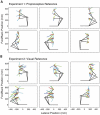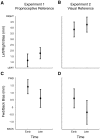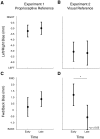Mapping proprioception across a 2D horizontal workspace
- PMID: 20686612
- PMCID: PMC2912297
- DOI: 10.1371/journal.pone.0011851
Mapping proprioception across a 2D horizontal workspace
Erratum in
- PLoS One. 2010;5(9) doi: 10.1371/annotation/5452a5f9-9d97-4be3-a4ca-bca4122b10fc.
Abstract
Relatively few studies have been reported that document how proprioception varies across the workspace of the human arm. Here we examined proprioceptive function across a horizontal planar workspace, using a new method that avoids active movement and interactions with other sensory modalities. We systematically mapped both proprioceptive acuity (sensitivity to hand position change) and bias (perceived location of the hand), across a horizontal-plane 2D workspace. Proprioception of both the left and right arms was tested at nine workspace locations and in 2 orthogonal directions (left-right and forwards-backwards). Subjects made repeated judgments about the position of their hand with respect to a remembered proprioceptive reference position, while grasping the handle of a robotic linkage that passively moved their hand to each judgement location. To rule out the possibility that the memory component of the proprioceptive testing procedure may have influenced our results, we repeated the procedure in a second experiment using a persistent visual reference position. Both methods resulted in qualitatively similar findings. Proprioception is not uniform across the workspace. Acuity was greater for limb configurations in which the hand was closer to the body, and was greater in a forward-backward direction than in a left-right direction. A robust difference in proprioceptive bias was observed across both experiments. At all workspace locations, the left hand was perceived to be to the left of its actual position, and the right hand was perceived to be to the right of its actual position. Finally, bias was smaller for hand positions closer to the body. The results of this study provide a systematic map of proprioceptive acuity and bias across the workspace of the limb that may be used to augment computational models of sensory-motor control, and to inform clinical assessment of sensory function in patients with sensory-motor deficits.
Conflict of interest statement
Figures











Similar articles
-
Robot-Aided Mapping of Wrist Proprioceptive Acuity across a 3D Workspace.PLoS One. 2016 Aug 18;11(8):e0161155. doi: 10.1371/journal.pone.0161155. eCollection 2016. PLoS One. 2016. PMID: 27536882 Free PMC article.
-
The proprioceptive map of the arm is systematic and stable, but idiosyncratic.PLoS One. 2011;6(11):e25214. doi: 10.1371/journal.pone.0025214. Epub 2011 Nov 16. PLoS One. 2011. PMID: 22110578 Free PMC article.
-
The cerebellum contributes to proprioception during motion.J Neurophysiol. 2017 Aug 1;118(2):693-702. doi: 10.1152/jn.00417.2016. Epub 2017 Apr 12. J Neurophysiol. 2017. PMID: 28404825 Free PMC article.
-
Spatially selective enhancement of proprioceptive acuity following motor learning.J Neurophysiol. 2011 May;105(5):2512-21. doi: 10.1152/jn.00949.2010. Epub 2011 Mar 2. J Neurophysiol. 2011. PMID: 21368000 Free PMC article. Clinical Trial.
-
Generalization of reach adaptation and proprioceptive recalibration at different distances in the workspace.Exp Brain Res. 2015 Mar;233(3):817-27. doi: 10.1007/s00221-014-4157-9. Epub 2014 Dec 6. Exp Brain Res. 2015. PMID: 25479737
Cited by
-
Robot-Aided Mapping of Wrist Proprioceptive Acuity across a 3D Workspace.PLoS One. 2016 Aug 18;11(8):e0161155. doi: 10.1371/journal.pone.0161155. eCollection 2016. PLoS One. 2016. PMID: 27536882 Free PMC article.
-
The influence of spatial working memory on ipsilateral remembered proprioceptive matching in adults with cerebral palsy.Exp Brain Res. 2012 Nov;223(2):259-69. doi: 10.1007/s00221-012-3256-8. Epub 2012 Sep 14. Exp Brain Res. 2012. PMID: 22975865
-
On the bimanual integration of proprioceptive information.Exp Brain Res. 2015 Apr;233(4):1273-88. doi: 10.1007/s00221-015-4205-0. Epub 2015 Jan 25. Exp Brain Res. 2015. PMID: 25618007
-
Perception of Arm Position in Three-Dimensional Space.Front Hum Neurosci. 2018 Aug 21;12:331. doi: 10.3389/fnhum.2018.00331. eCollection 2018. Front Hum Neurosci. 2018. PMID: 30186128 Free PMC article.
-
Bimanual proprioception: are two hands better than one?J Neurophysiol. 2014 Mar;111(6):1362-8. doi: 10.1152/jn.00537.2013. Epub 2013 Dec 31. J Neurophysiol. 2014. PMID: 24381030 Free PMC article.
References
-
- McCloskey DI. Kinesthetic sensibility. Physiol Rev. 1978;58:820. - PubMed
-
- Rothwell JC, Traub MM, Day BL, Obeso JA, Thomas PK, et al. Manual motor performance in a deafferented man. Brain. 1982;105 (Pt3):42. - PubMed
-
- Gordon J, Ghilardi MF, Ghez C. Impairments of reaching movements in patients without proprioception. I. Spatial errors. J Neurophysiol. 1995;73:60. - PubMed
Publication types
MeSH terms
Grants and funding
LinkOut - more resources
Full Text Sources
Medical

